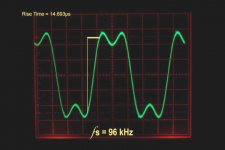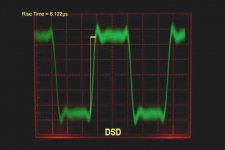Normally, rise time is more easily generated from a 'perfect' square wave by simply adding a determined RC time constant to create the rise time. However, the actual maximum rate of change is about twice as fast than the rise time would appear to imply, because the rate of change is faster at the beginning of the square wave and slows down subsequently. Now we can get into quibbling over what I just attempted to say and we can generate even more confusion. '-)
Real life high end audio demands a 10uS risetime square wave at any audio frequency.
My BS meter just pegged! First time since months...😉
Jan
Because that is what hi end sources can generate.
As in 'this broken DAC'? John? You KNOW that's BS. Why spread this nonsense, people come here for real information.
Jan
the faster the equipment can respond,
the more details will be present ...
(the details are in the high frequencies)
the more details will be present ...
(the details are in the high frequencies)
..................I wholeheartedly agree. As is uS in this context. I'm willing to let u pass for µ, but S is siemens, the unit for electrical conductance. Slew rate is measured in volt per second (V/s). Not volt per siemens (V/S)..................
Real life high end audio demands a 10uS risetime square wave at any audio frequency.
Now J.Curl & Bimo are showing their nickers on the washing line.I think he meant, 1Vpk need 1V/uS, 2Vpk need 2V/uS, etc...
Last edited:
Agonize a little over it. BW and rise time are not independent, BW[GHz]=0.35/RT[ns]
So for 500kHz BW the rise time calculates to 70ns, 175ns for 200kHz. 50ns leads to a 700KHz bandwidth. If one doesn't want the local AM stations to enter the input stage and get demodulated, 200-300KHz is a sweet spot. Then attenuation in the RF range is large enough to avoid the input stage entering nonlinearities due to the RF parasitically.
1V/us SR for each peak output volt is already over an order of magnitude over what is required to avoid SID (slewing induced distortions) or AAMF TIM. This rule of thumb is good enough. Now that you mentioned it, please explain why one would need 500V/us from a CFA topology 100W/8ohm audio amplifier.
The huge confusion between rise time and slew rate comes from missing their sources; while the rise time is natural in linear bandwidth limited amplifiers, as a small signal parameter, slew rate is essentially a nonlinear large signal effect. They have virtually nothing in common, a designer can control both independently. However, in the particular and trivial case of a single pole Miller compensated amp with a long tail pair at the input, the Miller cap controls both, this adds to the illusion the two phenomena are related.
No need for the lecture. I understand the relationship between rise time and BW.
I measure both on my amplifiers and they are in the specs including a note as to whether the front end filter was in-situ or not for the measurement.
No need to agonize over anything either - just use the spread sheet or the formulas . . .
Surely what matters is not what "high end sources" can generate, but what genuine music waveforms contain? "High end sources" presumably include unfiltered NOS DACs?
I know my DAC's filter is the "chokepoint" for slew rate. Whether I use my 40V
or 300V/uS amp stage makes no difference , both are many magnitudes
"overkill" for this source.
Can't say the same for a synthesizer output. Modular analog synth's can
slew at >20v/us , determined by the op-amps slew. I use one of these
"old school" (VCO's) to test SW response.
Plain old astable multivibrator generator is quite fast with a OPAxxxx
op-amp.
Lower slew rate Moog VCO's are preferred to a faster ARP VCO.
Lower slew rate = "the preferred Vintage sound".
Moog - 10V/us ARP=40V/uS ..... definite sound difference and general
preference by musicians.
So LOWER slew rate commands the demand !
The only advantage to a real fast amplification stage might be that
it adds nearly any additional change to the sources slew.
OS
or 300V/uS amp stage makes no difference , both are many magnitudes
"overkill" for this source.
Can't say the same for a synthesizer output. Modular analog synth's can
slew at >20v/us , determined by the op-amps slew. I use one of these
"old school" (VCO's) to test SW response.
Plain old astable multivibrator generator is quite fast with a OPAxxxx
op-amp.
Lower slew rate Moog VCO's are preferred to a faster ARP VCO.
Lower slew rate = "the preferred Vintage sound".
Moog - 10V/us ARP=40V/uS ..... definite sound difference and general
preference by musicians.
So LOWER slew rate commands the demand !
The only advantage to a real fast amplification stage might be that
it adds nearly any additional change to the sources slew.
OS
As in 'this broken DAC'? John? You KNOW that's BS. Why spread this nonsense, people come here for real information.
Jan
A 20KHz sine has a cycle of 50us, the first peak occur at t = 12.5us, so 10us rise time would induce at this frequency some slew rate limitation, so that s quite a modest requirement, for amplifiers at least..
I know my DAC's filter is the "chokepoint" for slew rate. Whether I use my 40V or 300V/uS amp stage makes no difference, both are many magnitudes "overkill" for this source.
-> Fresh from the Bench: Benchmark DAC2 DX Stereo D/A Converter | audioXpress
If I am not wrong, we will need 100 W / 8 Ohms amplifier with > 36.36 V/µsAnalog Circuitry
The analog circuitry in the DAC1 used TI NE5532 op-amps as I/V (current-to-voltage) converters, and Texas Instruments/National LM4562 op-amps elsewhere. The DAC2 uses Texas Instruments/National LME49860 chips throughout. I counted a total of 17 of these dual op-amps in the DAC2 DX. This high-performance audio IC features a slew rate of 20 V/µSec, gain bandwidth product of 55 MHz, very low voltage noise of 2.7 nV/√Hz, total harmonic distortion (THD) of 0.00003%, and will operate on up to ±22 V supply rails. The ES9018 has differential current outputs, and Benchmark feeds these to precision differential I/V converters to minimize common-mode distortion. The outputs of the differential amplifiers are AC-coupled with a corner frequency of 0.016 Hz. Siau mentioned that he prefers AC coupling to DC servos, and says that the keys to success with this approach are as follows:
- Set the corner frequency very low (under 0.1 Hz)
- Select good capacitors (Benchmark usually uses at least two
Last edited:
so 10us rise time would induce at this frequency some slew rate limitation
See? This exactly the kind of confusion I was mentioning.
Rise time cannot induce any slew rate limitations. It is directly related to the amplifier small signal bandwidth.
"Slew rate limitations" create nonlinear distortions while "rise time limitations" create "linear distortions" (as in phase errors, etc...). Easy to remember this way, although I don't support the concept of "linear distortions".
Once again, as a professional audio designer, I have to design for REASONABLE WORST CASE, not typical, or for some audio listener using only CD or worse, for playback. My clients may use 30 ips analog, or 192/24, DSD, or even faster audio sources. I have found by measurement that it both MC phono and 30ips analog master recorders can give 10us rise times. Also, our work on TIM has shown that the TIM(30) test signal is necessary for highest quality reproduction at minimum, and even faster might be even better. We established this 35-40 years ago, so many new to this subject may not be aware of this. The TIM(30) test signal has approximately a 10us rise time. This is where I establish that a 10us rise time is a minimum goal for insuring low TIM under all normal conditions. Now for some digital measurements: Please note that 10us is actually too slow for today's worst case (hi end) digital reproduction.
Attachments
There is indeed a lot of confusion on this issue.
For rise time I measure it at two levels
- small signal rise time: 2-3 V Pk to pk. This is the c. 50 ns I mentioned.
- large signal : about 70 to 80 % of the full output swing. Typically my amps measure 700ns to 1.2 us
Slew rate is different - for conventional VFA amps you have to switch the input LTP so that all the tail current is flowing into the Miller cap. In CFA's the mechanism is different and not limited by the tail current so SR's are much higher.
For rise time I measure it at two levels
- small signal rise time: 2-3 V Pk to pk. This is the c. 50 ns I mentioned.
- large signal : about 70 to 80 % of the full output swing. Typically my amps measure 700ns to 1.2 us
Slew rate is different - for conventional VFA amps you have to switch the input LTP so that all the tail current is flowing into the Miller cap. In CFA's the mechanism is different and not limited by the tail current so SR's are much higher.
Last edited:
Analog rise times were determined by analog measurements and are roughly equivalent to a 10us rise time. I did these measurements in the late 70's and early 80's.
10us or faster makes sense for hi end digital sources too, like 192K and SACD. And what about real hi end digital mastering? Faster yet?
Incidently, the best condenser microphones can have a rise time of 10us or less as well, like the B&K 1/2'' instrumentation mike, used by Mark Levinson, Crystal Clear records (direct disc) and other record producers.
Incidently, the best condenser microphones can have a rise time of 10us or less as well, like the B&K 1/2'' instrumentation mike, used by Mark Levinson, Crystal Clear records (direct disc) and other record producers.
That's where we have to look at first :
http://www.diyaudio.com/forums/soli...audio-transient-terms-v-us-3.html#post4512327
- Status
- Not open for further replies.
- Home
- Amplifiers
- Solid State
- What is the steepest realistic audio transient in terms of V/us?


